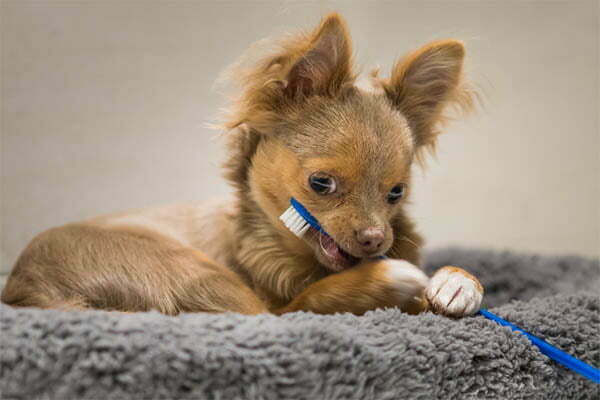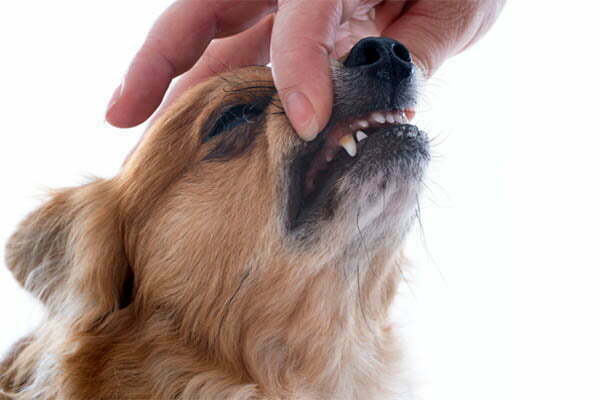
Dental care is important for your dogs. While you may be expected to keep the teeth of a large Labrador healthy, you must also keep the teeth of your small Chihuahua healthy.
We’ve all seen images of Chihuahuas baring their teeth online. The territorial and feisty nature of many Chihuahuas has led to images and videos of them circulated because it’s funny for such small dogs to think they rule the roost.
Their teeth are small and needle-like. They have to be because they’re fighting for space in a smaller mouth than the mouths of other canines.
Just how many teeth are in there? We’re answering that and more in today’s post. Below you’ll find your answer, along with why they have that many teeth, how they’re positioned, and common dental problems that Chihuahuas have to contend with.
How Many Chihuahua Teeth?
The adult Chihuahua packs forty-two teeth in their little mouths. That’s ten more than human beings! Like most other mammals, those teeth are made up of incisors, canines, premolars, and molar teeth.
Also, as the Chihuahuas get older, it’s natural for them to lose a few teeth through decay or accidentally loosening them when playing. This happens without causing any stress or danger for your Chihuahua.
Also, like mammals, Chihuahuas start with milk teeth that later fall out and are replaced with adult teeth. They start with twenty-eight milk teeth before upgrading to forty-two proper teeth by the time they hit eight months of age.
Chihuahua Teeth
Chihuahua teeth are arranged in groupings that spread from the front to the back of the mouth. Starting at the front, the teeth you’ll be seeing most in your Chihuahua’s mouth are incisors.
From there, there are four canines, sixteen premolars, and ten molars right at the back. It’s a lot like a human dental structure.
You can see the common dog dental structure here, thanks to this chart from Purina Dentalife (who also owns the copyright).
Here you can appreciate the structure of a Chihuahua’s mouth and how each grouping of teeth is arranged and placed.
Since 42 is a nice and even number, the teeth groupings are even divided up quite neatly instead of being mixed together and confused.
Here’s a short breakdown of how each group of teeth is arranged and what they’re designed to do for your Chihuahua.
Incisors
There are a total of twelve incisor teeth in total. As we said, these are the teeth that probably come to mind when you think about a Chihuahua with its mouth open.
They’re two rows of small, needle-like biters that are arranged equally, so there are six in their top gums and six in their bottom.
They look like short combs, which makes sense because that’s one of the functions of a Chihuahua’s incisors. They’re for scraping, so if something needs removing, preferably into the Chihuahua’s mouth, then these are the teeth for the job.
They’re used to scrape the meat away from bones and, when they self-groom, they drag the incisors across their fur to clean themselves.
Canines
Just like us, Chihuahuas have four canines situated in roughly the same places, two on the bottom jaw and two on the top. They’re the longest teeth, often called fangs, and are visible when Chihuahuas bare their teeth.
This is the same for nearly every mammal too, as it’s the canines that have evolved to do the most damage by puncturing and tearing meat apart.
While your Chihuahua isn’t going to hunt wildebeest down anytime soon, those canines are still for biting down and damaging meat so that the incisors can scrape it away deeper into the mouth.
If you hadn’t yet noticed, these teeth are literally named from the Latin word for dog – Canis.
Premolars
These are the teeth that are just behind the canines of the Chihuahua and are used to chew down most food material. Since they’re tucked behind the canines, these are harder to see when your dog is baring its teeth.
There are sixteen premolars, eight on the bottom jaw and eight along the top jaw.
If you watch your Chihuahua when they chew, it’ll look like they’re engaging the food with the side of their mouth. This is them chewing with their premolars.
Molars
Just like with our molars, these are the heavy-duty teeth right at the back of the Chihuahua’s mouth. They’re platforms that are used to concentrate bite pressure down on harder foods, so this is where Chihuahuas will break hard dog food.
Since they are flatter on top, they’re better for applying pressure and grinding up food.
Chihuahuas have uneven molars across the top and bottom of their jaws. They have four molar teeth at the top and six at the bottom, making ten in total.
Chihuahua Teeth Problems
You should know the dental structure of Chihuahua teeth because you need to be able to identify and treat any teeth problems that develop.
If even healthier Chihuahuas are prone to losing a tooth or three, you need to be careful when it comes to tooth problems in Chihuahuas as they can lose even more and develop infections.
It’s a common misconception that dogs can grow their teeth back. The best way to answer that is with a question.
Can you grow your teeth back? Looking at how strikingly similar the dental structure of a Chihuahua is to what we have going on, it’s fair to say that we’re all operating from the same toolkit and, except for a few species, mammals cannot grow back their teeth.
If your Chihuahua loses an adult tooth, it isn’t coming back. This means you need to take care of your Chihuahua’s teeth with the same care that we do for our own.
Common Dental Issues

Chihuahuas are prone to dental issues that stem from tartar buildup. These problems often end with missing teeth if treated, something which is sadly common for Chihuahua dogs.
Some cases get so bad that the affected Chihuahua loses all of its teeth, though the severity of each case depends on the genetics of the dog and the circumstances that led to tooth loss.
The solidification of plaque into tartar or calculus is the main concern with Chihuahua teeth. Some Chihuahua lineages will suffer more from this than others, so a Chihuahua can hit fourteen without losing all of its teeth while a three-year-old Chihuahua will have lost all of its teeth.
Tooth loss is down to periodontal disease, where the bacterium of the tartar starts an infection in the gums. It’s often called the number one issue that threatens the health of Chihuahuas. It isn’t just a tooth issue, either, as it can cause serious harm.
If the infection gets too bad, the infection can even dissolve the bottom jaw of your Chihuahua. With larger dog species this is a nuisance but with Chihuahuas, this can be fatal or disable its jaw.
Why Are Chihuahua Teeth So Bad?
It’s simple, really. The smaller the dog, the more risk there is of them developing periodontal disease. Since Chihuahuas are brachycephalic, they have snubbed noses that make their mouth space much smaller than larger breeds.
Maybe it’s because the mouth is more cramped and prone to developing bacteria, or there are more places where food can get trapped.
The bacteria form plaque over time and then, after a certain amount of time, they harden into tartar where the decay continues. When the decay becomes too much, a Chihuahua’s teeth will start falling out.
Either way, smaller dogs suffer more from periodontal disease and there are not many dogs that are smaller than Chihuahuas. Smaller dogs have so many teeth that they’re crammed together and give small dogs a distinct appearance when baring teeth.
Preventing Chihuahua Tooth Loss
Chihuahuas are high-maintenance when it comes to their little teeth. As an owner, you should want your dog to have their teeth for most, if not all, of their lifetime.
To do that, you’ll need to follow a strict dental routine that cleans and safeguards your Chihuahua’s teeth so they can keep their smile long into their golden years.
To introduce an oral hygiene routine to your Chihuahua, you should be doing the following things:
- Take your Chihuahua to the vet for examinations of the teeth and gums.
- Professional teeth cleaning periodically.
- Buy a dog dental kit and use that to brush your Chihuahua’s teeth at home.
- Regularly take a look at your dog’s teeth and mouth hygiene to keep track of the issue.
So, how many times should you wash your Chihuahua’s teeth? Well, veterinarian experts advise that it must be done every year.
This should preferably be a meeting with a professional who can do a good job of clearing hardened tartar and calculus. Staying on top of the above points is important because it keeps your Chihuahua healthy and happy.
If you don’t properly clean your Chihuahua’s teeth then its health is on the line. At best, your dog will lose a few teeth and may have trouble chewing hard foods. At worst, your dog could require medical attention and even need to be put down.
Conclusion
With just as many teeth as an average dog, the smaller mouths of Chihuahuas don’t mean that you can ignore their oral hygiene.
By learning the above information, you can find out how Chihuahua dental structures are formatted and how to combat the common medical problems this species has to contend with.
Enact the oral hygiene practices outlined above and get to know your veterinarian better if your Chihuahua is exhibiting the signs of periodontal disease.
In most cases, catching the disease early will save the dog’s teeth and a lot of gum lining, so there’s nothing to lose by helping your dog.
If you take the right precautions, you can ensure your Chihuahua reaches old age with most of its teeth intact, maybe all of them, so it’ll be able to have a big smile on its face.
